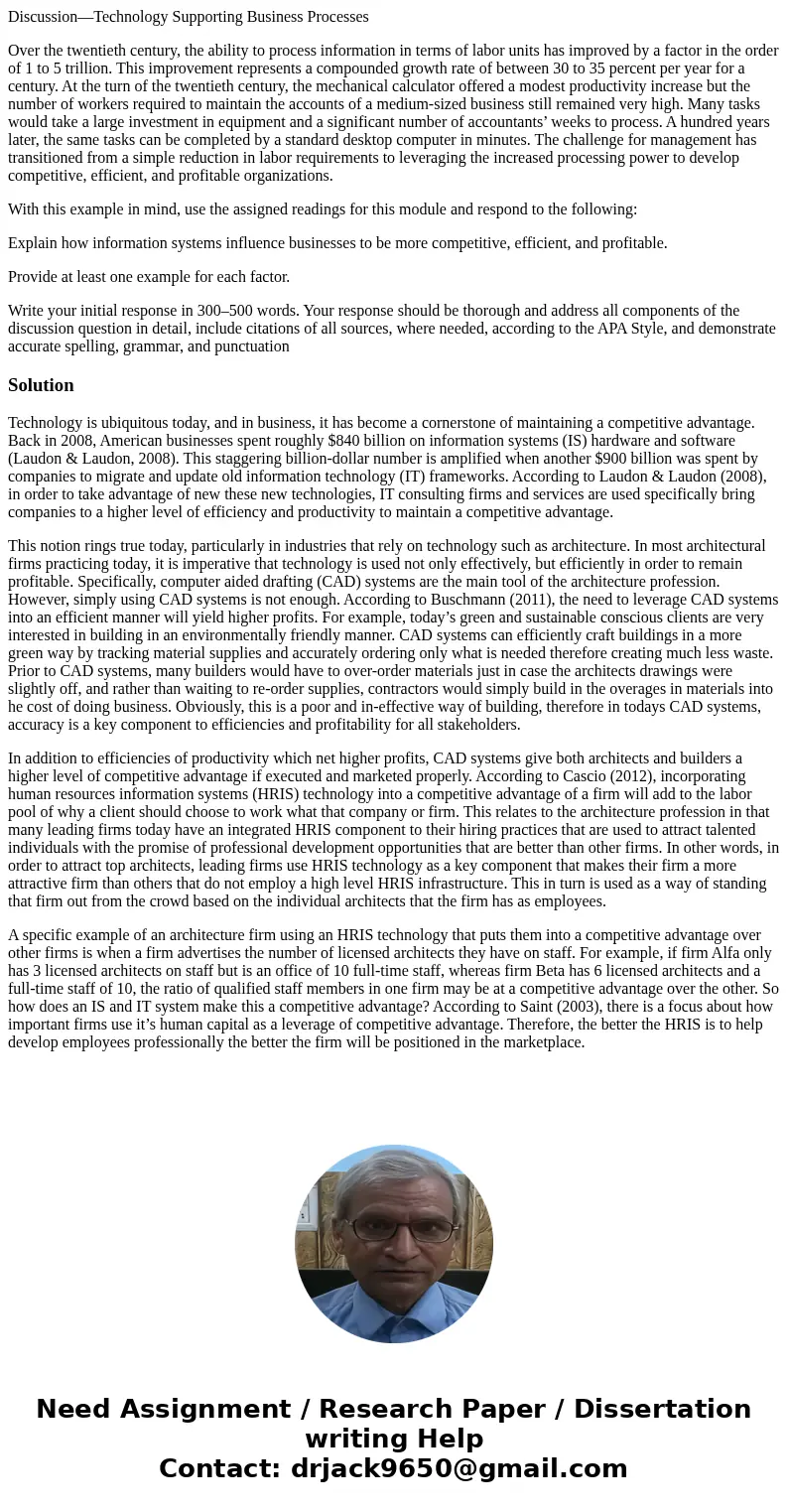DiscussionTechnology Supporting Business Processes Over the
Discussion—Technology Supporting Business Processes
Over the twentieth century, the ability to process information in terms of labor units has improved by a factor in the order of 1 to 5 trillion. This improvement represents a compounded growth rate of between 30 to 35 percent per year for a century. At the turn of the twentieth century, the mechanical calculator offered a modest productivity increase but the number of workers required to maintain the accounts of a medium-sized business still remained very high. Many tasks would take a large investment in equipment and a significant number of accountants’ weeks to process. A hundred years later, the same tasks can be completed by a standard desktop computer in minutes. The challenge for management has transitioned from a simple reduction in labor requirements to leveraging the increased processing power to develop competitive, efficient, and profitable organizations.
With this example in mind, use the assigned readings for this module and respond to the following:
Explain how information systems influence businesses to be more competitive, efficient, and profitable.
Provide at least one example for each factor.
Write your initial response in 300–500 words. Your response should be thorough and address all components of the discussion question in detail, include citations of all sources, where needed, according to the APA Style, and demonstrate accurate spelling, grammar, and punctuation
Solution
Technology is ubiquitous today, and in business, it has become a cornerstone of maintaining a competitive advantage. Back in 2008, American businesses spent roughly $840 billion on information systems (IS) hardware and software (Laudon & Laudon, 2008). This staggering billion-dollar number is amplified when another $900 billion was spent by companies to migrate and update old information technology (IT) frameworks. According to Laudon & Laudon (2008), in order to take advantage of new these new technologies, IT consulting firms and services are used specifically bring companies to a higher level of efficiency and productivity to maintain a competitive advantage.
This notion rings true today, particularly in industries that rely on technology such as architecture. In most architectural firms practicing today, it is imperative that technology is used not only effectively, but efficiently in order to remain profitable. Specifically, computer aided drafting (CAD) systems are the main tool of the architecture profession. However, simply using CAD systems is not enough. According to Buschmann (2011), the need to leverage CAD systems into an efficient manner will yield higher profits. For example, today’s green and sustainable conscious clients are very interested in building in an environmentally friendly manner. CAD systems can efficiently craft buildings in a more green way by tracking material supplies and accurately ordering only what is needed therefore creating much less waste. Prior to CAD systems, many builders would have to over-order materials just in case the architects drawings were slightly off, and rather than waiting to re-order supplies, contractors would simply build in the overages in materials into he cost of doing business. Obviously, this is a poor and in-effective way of building, therefore in todays CAD systems, accuracy is a key component to efficiencies and profitability for all stakeholders.
In addition to efficiencies of productivity which net higher profits, CAD systems give both architects and builders a higher level of competitive advantage if executed and marketed properly. According to Cascio (2012), incorporating human resources information systems (HRIS) technology into a competitive advantage of a firm will add to the labor pool of why a client should choose to work what that company or firm. This relates to the architecture profession in that many leading firms today have an integrated HRIS component to their hiring practices that are used to attract talented individuals with the promise of professional development opportunities that are better than other firms. In other words, in order to attract top architects, leading firms use HRIS technology as a key component that makes their firm a more attractive firm than others that do not employ a high level HRIS infrastructure. This in turn is used as a way of standing that firm out from the crowd based on the individual architects that the firm has as employees.
A specific example of an architecture firm using an HRIS technology that puts them into a competitive advantage over other firms is when a firm advertises the number of licensed architects they have on staff. For example, if firm Alfa only has 3 licensed architects on staff but is an office of 10 full-time staff, whereas firm Beta has 6 licensed architects and a full-time staff of 10, the ratio of qualified staff members in one firm may be at a competitive advantage over the other. So how does an IS and IT system make this a competitive advantage? According to Saint (2003), there is a focus about how important firms use it’s human capital as a leverage of competitive advantage. Therefore, the better the HRIS is to help develop employees professionally the better the firm will be positioned in the marketplace.

 Homework Sourse
Homework Sourse